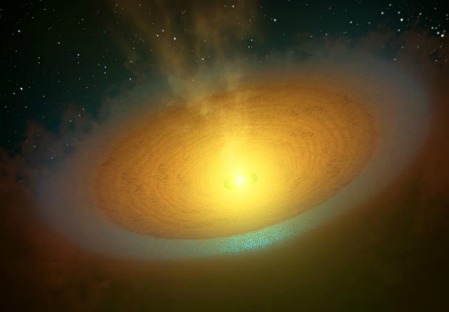
This artist's concept illustrates an icy planet-forming disk around a young star called TW Hydrae, located about 175 light-years away in the Hydra, or Sea Serpent, constellation. Courtesy NASA/HSO
The translation of the constellation Hydra is Water Serpent, and astronomers now know the name is strangely appropriate for at least part of the formation. One of the fainter stars in the serpent is an orange-dwarf tagged TW Hydrae, it’s about 176 light-years away. Astronomers have known for some time this star is very young, and more recently a protoplanetary disk has been detected around the infant star. Now, astronomers have refined a technique which measures spin in molecules making up the disk and found something intriguing. Phil Plait explains the nifty science:
Each hydrogen atom has a proton in it, and protons have a property scientists call spin. They can spin either one way or another; scientists call this spin up or spin down. This is important because the total amount of energy in a water molecule is different if the two hydrogen atoms spin the same way (say, both up) versus different ways (one up and the other down). The first case is called ortho, and the second para. Each emits a slightly different wavelength of light, which can be measured if you’re careful.
That analysis is what allowed astronomers to pin down the temperature of the water in the disk. And surprise, it’s chilly! Which means it has to be distributed all over the disk well away from the star. They further estimated the total water volume at about 1000 times all the water in all the oceans of earth!
That’s important to us water-bags. Our bodies are mostly made of good ole dihydrogen monoxide, H2O, so we tend to think pretty highly of the stuff. Follow the water is the mantra among astro-biologists these days, whether its the ancient dunes of Mars or a the distant misty eye of a cosmic sea serpent. This find suggests that alien seas on worlds young and old are common throughout the galaxy and, we can speculate, life would have a fighting chance to exist in some of them. I wonder what they would be like?

Leave a Reply
You must be logged in to post a comment.